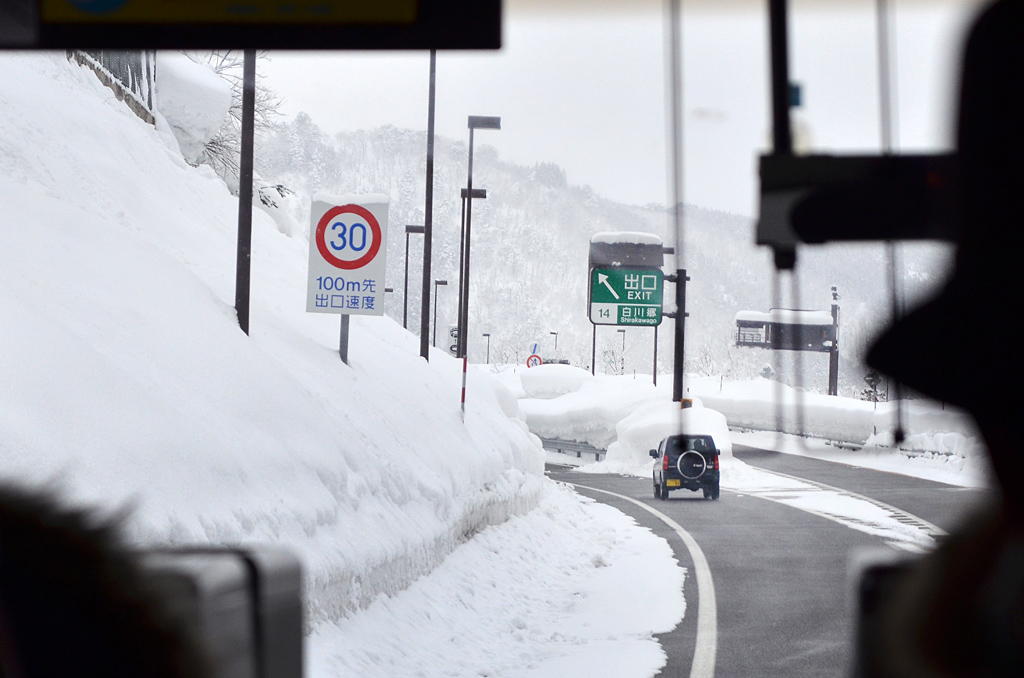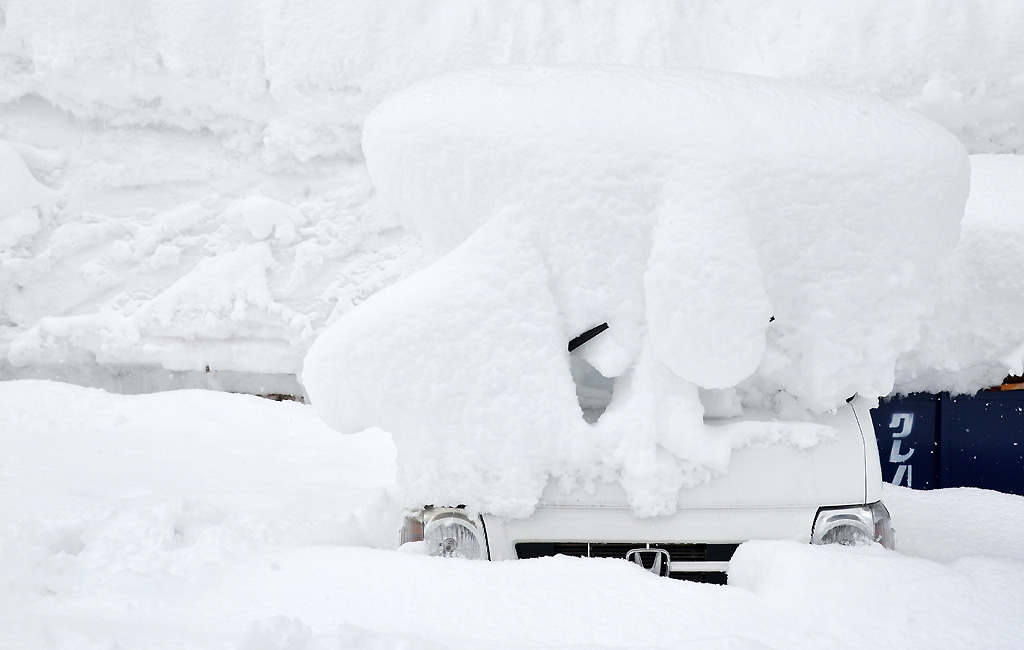 |
Woke up in the morning and discovered that the temperature was dropping each day, and the snow was getting thicker outside the window.
|
 |
 |
After breakfast, we took a stroll around town before heading to the bus station. Walked past the Hida Kokubun-ji temple again and it was transformed into a winter wonderland.
|
 |
 |
The streets were completely covered in white after a night of snowfall. Some cars had almost been buried.
|
 |
Frozen in time.
|
 |
| Ice-cycle. |
 |
Walking along the main road towards Takayama bus station. Before the trip, I thought snow boots would not be necessary. I thought it was exaggerating. Well, I was wrong.
|
 |
| Crystal ball. |
 |
Waiting for our bus in the Takayama bus station to Shirakawa-go. Tickets may be purchased at the info/ticketing counter in the bus station in advance (behind the glass door). It costs 4,420¥ per person for a non-reserved return ticket.
Buses to Shirakawa-go depart from bus bay number 4. A long queue had formed 30 minutes before departure time. The morning buses depart at 8.50am, 9.50am,10.50am and 11.50am for non-reservation seats. We took the 10.50am bus and reached Shirakawa-go just before noon. The journey typically takes 50 minutes to an hour. More info on the bus schedule here: http://www.nouhibus.co.jp/english/shirakawago_kanazawa.html
|
 |
Exiting the snow-filled highway to Shirakawa-go.
|
 |
Mesmerizing scenery of snow-covered landscape along the way.
|
 |
Arriving at Shirakawa-go (白川郷) after an hour's journey. This is the car park and bus stop area.
|
 |
It's not hard to imagine how much snow has been falling over this winter.
|
 |
The elegant suspended pedestrian bridge that connects the bus stop and information centre to the main village across the river.
|
 |
A panoramic view of the Shogawa river valley with the village of Shirakawa-go (白川郷) on the opposite side.
|
 |
Watch your steps as the thick snow could mislead where the edge is. A cold bath might not be what you need during winter.
|
 |
 |
Has anyone seen my van?
|
 |
 |
 |
 |
 |
Getting ready for European Rally Championship winter challenge.
|
 |
Self portrait with the Ogimachi Shirakawa-go village in the background.
|
 |
A breath-taking panoramic view of the Ogimachi Shirakawa-go village.
|
 |
 |
 |
 |
The huge attic in Wada's house, which was used to house and rear silkworms.
|
 |
The living area within Wada's house.
|
 |
The irori (sunken fireplace) in the house. The openings on the ceiling allow smoke from the fireplace to rise, preserving the wooden beams and ropes in the attic above.
|
 |
The footpath leading to the entrance of Wada's house, if you could see where the path is.
|
 |
| A tourist posing with Olaf the snowman from Disney's Frozen. |
 |
Public toilets are not available everywhere in the village. Most are located along the main street. Use it immediately when you see it when you need to.
|
 |
Late lunch in one of the restaurants along the main street. The restaurants can get quite crowded due to the limited options and large number of tourists. Probably want to avoid peak lunch hour.
|
 |
| My bottle of hot sake with lunch. Keeps you warm and makes you happy. |
 |
The main street with continued heavy snowfall.
|
 |
Looking back one more time at this beautiful village before heading to the bus stop. Just didn't want to leave. Will definitely plan to go back again and stay in one of the gassho-zukuri houses.
|
 |
In the queue and waiting for our bus back to Takayama. The bus stop doesn't have a shelter. Be thankful of what we have in Singapore.
|
 |
The true meaning of cold engine and cold start.
|
 |
| Started the day with a walk at the Hida Kokubun-ji temple, and I shall end with the same. |
GENERAL INFORMATION:
- Date: February 2015
- Accommodation: Ryokan Asunaro, Takayama (http://www.yado-asunaro.com/english/)
GENERAL TIPS:
- The weather could feel colder than the numbers suggest due to wind and flurry. It's better to be over-prepared than under-provided. Do bring along REAL winter jackets from reliable makers.
- Jackets with hoods are absolute essentials. Scarfs, neck and face warmers are very effective as well. Some locals were even wearing ear muffs.
- Bring a good pair of gloves that are thick enough but also fit well. Better if it's a pair of touchscreen-enabled gloves since we use our smartphones so often. It can be annoying if you are planning to use your smartphone as your camera and need to remove your gloves every now and then.
- Consider bringing heat packs as well to add some warmth in your pockets.
- Cold weather is dry weather. Bring some REALLY good moisturiser with you. Those little travel-size tubes will not be enough as it's easy to underestimate the amount of moisturiser needed everyday. Bring different types if you are particular about application on different areas like body and face (remember to check-in if it exceeds 100ml).
- Get a pair of snow boots or equivalent. Sinking your feet into thick snow (intentionally, inevitably or accidentally) means water seepage into your shoes. Having water in your shoes and wetting your socks in winter do not seem like a good idea.
- Walking on icy surfaces is extremely slippery too. I've seen many people in their usual sneakers, running or cross-trainer shoes slipped and fell. Otherwise, you may buy an ice-spike sole attachment (around 1,500¥ a pair) to enhance your foot grip. They are available in most souvenir shops.
- A pair of shades/sunglasses would be useful as the snowy landscape can be rather glaring.
PHOTOGRAPHY INFO & TIPS:
- Was using Nikon D5100, Nikon AFS DX 10-24mm f3.5-4.5, Sigma 17-70mm f2.8-4 DC, Nikon AFS 50mm f1.4, Nikon AFS VR 70-200mm f2.8, Sony HX50V, Sony Action Cam AS30V, Apple iPhone 6, Samsung Galaxy Edge.
- Other than keeping your hands warm and functionable, gloves should be of perfect fit to handle and operate your camera easily. Best if they are designed for winter photography. Get touchscreen-enabled gloves if you're using cameras with touchscreen feature.
- Consider bringing cameras with bigger buttons and controls if you don't mind the bulk. I find it hard to use those tiny buttons on the D5100 with my gloves on.
- Make sure your equipment can be used in sub-zero environment. Perhaps, do a test in your home fridge before your trip. This includes your lens as many lenses have complex electronic components these days.
- Use a lens hood. It can be useful to prevent snow from hitting the glass directly, which can be annoying and hard to wipe dry.
- Extra batteries are critical as they deplete fast in cold weather.
- A waterproof outermost jacket with a hood could potentially eliminate the need to carry an umbrella during light snow. Imagine carrying an umbrella while trying to shoot.
- Most indoor areas are well heated during winter, which is great for us but not our lenses. If you have stayed in the warm indoors for long enough (e.g. for a meal), condensation will occur. Hence, try to keep your camera cold in the bag if you want to be able to shoot immediately.













No comments:
Post a Comment